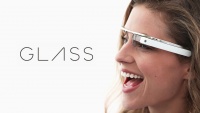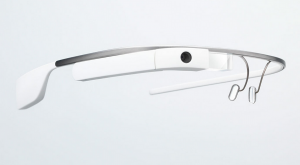Google Glass
|
Google Glass is a form of head-mounted technology worn in a similar fashion to regular eyewear. Developed by Google with the goal of Ubiquitous Computing in mind, Google Glass performs the functions of such hand-held technology as smart phones through optical displays and voice control. A prototype of the product was distributed to a group of people in the United States called “Glass Explorers” on April 15, 2013 for $1,500. It was available to be purchased by the public for the same price for a short amount of time starting in May of 2014. After growing concerns and criticism, Google pulled the prototype from production and distribution on January 15, 2015. However, the company continues to develop Google Glass in an effort to try to perfect the technology. [1]
Contents
Development
Google Glass was created by a subsection of Google called Google X. This is a research and development facility that has also worked on other largely innovative projects including the driverless car, an aerial delivery service similar to Amazon Prime Air, and even some currently rejected ideas such as a space elevator and teleportation. [2] Project Glass was announced in April 2012. It was not the first product of it’s kind as it has been preceded by other optical technologies in both the video game and military fields. [3]The current prototype is much smaller in scale and is now even lighter than a normal pair of glasses. For an extra fee of $225, Google provides multiple versions of prescription frames for users who require them. They have also worked with popular brands of eyewear such as Oakley and Ray Ban to design frames that differ from the original style. [1]
The original version of Google Glass was offered to be tested by a group of qualified individuals known as “Glass Explorers.” The first 2,000 of these were chosen from attendees at a June 2012 conference where Sergey Brin, the co-founder of Google, gave a demonstration of the product. Eventually this opportunity was made available to everyone. Google chose interested and creative people via Google+ or Twitter applications where individuals explained what they would do if they had access to Google Glass using the hashtag #ifihadglass. Glass Explorers received and began using their devices on April 16, 2014 – the day it went public. [4]
It was announced in January 2015 that the Glass Explorer program would be terminated and the devices would no longer be available to purchase in that way. In the mean time, Google is still working to improve the product as part of its own department within the company. [4]
Device
Google Glass itself is essentially a device containing all of the functions of a smart phone in the form of a headset worn similarly to eyeglasses. There is a small prism-like screen [5] attached to the corner of one of the frames that serves as the display fitted with LED illumination. The beam splitter within the lens reflects the light given off at 45° into the user’s eye. The device comes equipped with a camera able to take photographs and 720p HD video as well as various other applications installed allowing access to social media, email, etc. All of this is controlled by a small touch pad found on the side of Google Glass that allows swiping through information on the screen and the use of natural language voice commands seen with Cortana, for example. [1]
Software
Uses
There are many uses of Google Glass, all managed through a small headset that appear to be glasses. Some common functions of Google Glass are viewing the weather for the day, dictating text messages, and even getting event reminders when something is scheduled in a users Google Calendar app. One function of the Google Glass app that users have been fretting about is the Maps application on Gooogle Glass. When prompted, the headset will bring up a live feed of the map on the Google Glass headset. However, this map is placed directly in the center of the field of view of the user. The map blocks out crucial lines of sight, and potentially presents danger from the user because it inhibits the field of view for the user, and also has the ability to be a distraction.
Ethical Concerns
Privacy
A large portion of the criticism over the use of Google Glass concerned the issue of privacy. Fear rose over the idea of wearers of the product being able to discreetly photograph and record those around them without their knowing consent and for any variety of reasons. This plays into questions of the use of facial recognition software as way to identify people in public and therefore document their actions or conversations. [1] In an effort to reduce this anxiety, Google announced in 2013 that it would not allow any applications on Google Glass that would allow for facial recognition "without strong privacy protections in place." [4] Because of the nature of Google Glass - close to the body, display only seen by the individual user - it is difficult to determine whether a user is simply checking their email or is up to something that is intrusive towards those around them. Even though Google Glass is no longer on the market, some companies are clear that they will not allow their patrons to wear the devices while on their property for this reason. Nations such as Russia and the Ukraine have raised legal concerns about this topic as the countries themselves did not allow "spy gadgets" that can document others in inconspicuous ways prior to the release of Google Glass. [1]
The issue of privacy does not only deal with the safety of potential victims of this violation, but the safety of Google Glass wearers. There are multiple cases of violence towards users because of mistrust of the technology from others around them at the time. One particularly noted case was of a woman showing her friend how Glass worked in a San Francisco bar. She was aggressively approached by two women and a man who noticed her recording the public scene. They tore off the device from her head and stole her purse and phone. These people reacted negatively to the idea that everything they were doing was being monitored or recorded and their backlash was directed toward the woman who did not appear to have any malicious intent. [6]
Accessibility
While it has been tested with some groups of people with varying disabilities and shown potential, Google Glass still lacks features that will allow full accessibility for all. Right now it is easy for blind users to get lost in the interface even with voice commands. The display can quickly go into sleep mode and they will continue to speak not knowing that this has happened. An improved talkback system would be useful to provide hints and easier navigation throughout the software. [7]
For deaf or hard of hearing individuals, it can be hard to control Google Glass if they do not speak or the device is not able to understand what they are saying when they do. There is no other way to input information besides the natural language voice commands so communicating with the device could be next to impossible for some. Conversely, Google Glass often speaks back to the user but provides no captions for the hearing impaired to read during these times. Physically wearing Glass can be a problem if the person already is fitted for a hearing aid or cochlear implant. [8]
Safety
Personal safety of users has also been expressed. Most often this was seen in concerns about operating motor vehicles and other equipment while wearing Google Glass - similar to arguments raised over texting and driving.
There have been reports of headaches and eye pain after adopting this technology which Google's own optometrist Dr. Eli Peli confirmed. [9]
Pornography
In the summer of 2013, a Google Glass application called “Tits and Glass” was released into the Google App Store. This app, which allowed users to upload and share pornographic material through their Google Glasses, was quickly removed from the App Store for violations of Google's terms of service (only to be reinstated months later) [10]. While today’s media patrons want to use the technology they have at their fingertips to get their hands on sexual content, censorship and regulating sexual content is still an aspect of net pornography. Unlike analog forms that regulated content by simply not supplying it, some digital pornography files and websites are made less accessible to users. Many online search engine institute default moderating filters that hide any “unsafe” images[11]. Google is one of these search engines, and perhaps because Google wants to be the “perfect search engine” [12] they want all Google services to be “safe” including Google Glass. Nevertheless, the fact that their Google Glass customers have the same motives as any Google-r (who has the same motives as any media user) leads them to expect the same variety in terms of applications that they can receive from any other internet service. Therefore, it is clear that Google Glass reinstated Tits and Glass at least partially due to the fact that their users demand and expect a variety of options of applications and accessibility to whatever content they fancy.
See Also
External Links
References
- ↑ 1.0 1.1 1.2 1.3 1.4 Wikipedia: [1]
- ↑ Wikipedia: [2]
- ↑ The World As Perpetual Beta: [3]
- ↑ 4.0 4.1 4.2 Glass Almanac: [4]
- ↑ The Washington Post: [5]
- ↑ Huffington Post: [6]
- ↑ Accessibility: [7]
- ↑ Mashable: [8]
- ↑ Observer Business & Tech: [9]
- ↑ "The “Tits and Glass” porn app was up for several hours before google sneak-changed their terms of service and took it down" http://glass-apps.org/tits-glass-google-glass-app (June 3, 2013)
- ↑ Paasonen, S. (2011). Bad taste, miasmis forces, and the ubiquity of online porn. Carnal resonance: Affect and online pornography. Cambridge, MA: MIT Press.
- ↑ Vaidhyanathan, S. (2011). The googalization of everything (and why we should worry). University of California Press.

